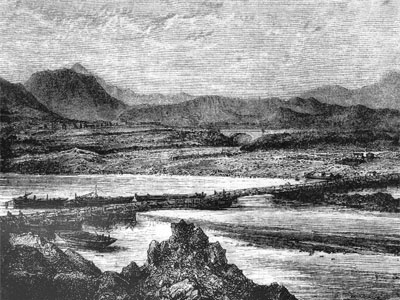|
Romancing the rivers in Punjab
A series of treaties between the
British and the Sikhs enabled the use of Sutlej and Indus rivers for
navigation and commerce
G. S. Aujla
 Having
found a foothold at Port William in Calcutta in 1600, the East
India Company was looking for a shorter route to India by the Arabian
Sea. In pursuit of this scheme, Sir Thomas Roe was sent as ambassador
of England to the Mughal court of emperor Jehangir on behalf of the
East India Company in the beginning of the 17th century. Sir Thomas
Roe reported that the best way to enhance the trading possibilities
was to use the "commodious" river Indus (Sindh) as a means
of water transport from the west. What was daunting at that time was
the ignorance about the navigational suitability of river Indus and
its connectivity with other major rivers of western India and the
Punjab. Having
found a foothold at Port William in Calcutta in 1600, the East
India Company was looking for a shorter route to India by the Arabian
Sea. In pursuit of this scheme, Sir Thomas Roe was sent as ambassador
of England to the Mughal court of emperor Jehangir on behalf of the
East India Company in the beginning of the 17th century. Sir Thomas
Roe reported that the best way to enhance the trading possibilities
was to use the "commodious" river Indus (Sindh) as a means
of water transport from the west. What was daunting at that time was
the ignorance about the navigational suitability of river Indus and
its connectivity with other major rivers of western India and the
Punjab.
 The East India Company
had to wait for over two centuries before an opportunity to fathom
these river courses came their way. It was in 1830 that an
enthusiastic young officer Captain Alexander Burnes was deputed to
navigate the ‘Sindh and Sikh courses’of the rivers. Ostensibly,
Burnes was assigned the duty of transporting five dray horses
presented by the King of England William IV to Maharaja Ranjit Singh
on a flat-bottomed boat, a thousand kilometres upstream at Lahore from
Karachi. Under the cover of these ‘Trojan horses,’ he would
explore the rivers. But the exploratory voyage of Captain Burnes
proved full of vicissitudes. The suspecting Talpur chiefs detained him
at the delta at Thatta for three months because they suspected him of
carrying arms. At long last, the boat was thoroughly searched and no
arms having been found they eventually let him off for his onward
journey to Lahore, little knowing that the boat carried ‘surveying
instruments’ to measure and plummet the depth of the river at
various points. The East India Company
had to wait for over two centuries before an opportunity to fathom
these river courses came their way. It was in 1830 that an
enthusiastic young officer Captain Alexander Burnes was deputed to
navigate the ‘Sindh and Sikh courses’of the rivers. Ostensibly,
Burnes was assigned the duty of transporting five dray horses
presented by the King of England William IV to Maharaja Ranjit Singh
on a flat-bottomed boat, a thousand kilometres upstream at Lahore from
Karachi. Under the cover of these ‘Trojan horses,’ he would
explore the rivers. But the exploratory voyage of Captain Burnes
proved full of vicissitudes. The suspecting Talpur chiefs detained him
at the delta at Thatta for three months because they suspected him of
carrying arms. At long last, the boat was thoroughly searched and no
arms having been found they eventually let him off for his onward
journey to Lahore, little knowing that the boat carried ‘surveying
instruments’ to measure and plummet the depth of the river at
various points.
 Maharaja Ranjit Singh
had an obsessive appetite for horses and was overwhelmed to receive
the prestigious dray horses sent by King of England which Captain
Burnes has so perilously ferried upto Lahore. His meeting with the
Sikh emperor paved the way for undertaking a series of treaties which
fostered friendship between the British and Sikh empires and finalised
the modalities of navigation in Punjab rivers right upto Ropar in the
river Sutlej. Captain Burnes’ mission found an avid supporter in
Captain C.M. Wade, the British agent at Ludhiana who convinced Lord
William Bentinck and Sir Charles Metcalfe to sign a treaty of
friendship with Ranjit Singh at Ropar on October 31, 1831. It was
succeeded by a treaty signed on December 26, in Lahore in 1832 which
spelt out the details of trade and commerce. Article 4 of the 1832
treaty spelt out the details of commerce as follows:- Maharaja Ranjit Singh
had an obsessive appetite for horses and was overwhelmed to receive
the prestigious dray horses sent by King of England which Captain
Burnes has so perilously ferried upto Lahore. His meeting with the
Sikh emperor paved the way for undertaking a series of treaties which
fostered friendship between the British and Sikh empires and finalised
the modalities of navigation in Punjab rivers right upto Ropar in the
river Sutlej. Captain Burnes’ mission found an avid supporter in
Captain C.M. Wade, the British agent at Ludhiana who convinced Lord
William Bentinck and Sir Charles Metcalfe to sign a treaty of
friendship with Ranjit Singh at Ropar on October 31, 1831. It was
succeeded by a treaty signed on December 26, in Lahore in 1832 which
spelt out the details of trade and commerce. Article 4 of the 1832
treaty spelt out the details of commerce as follows:-
"The merchants
coming from Amritsar and other parts on the right bank of the river
Sutlej, are to intimate their intentions to the Agent of the Maharajah
at Herreeke, or other appointed places, and obtain a passport through
him; and merchants coming from Hindoostan or other parts on the left
bank of the River Sutlej will intimate their intentions to the
Honourable Company’s Agent, and obtain a passport through him. As
Foreigners and Hindoostanees and Sirdars of the protected Sikh States
and elsewhere are not in the habit of crossing the Sutlej without a
passport from the Maharajah’s officers, it is expected that such
persons will hereafter also conform to the same rule, and not cross
without the usual passports."

(From top) The boats in Phillaur on the river Sutlej; ferrys on the Indus; Alexander Burnes, who ferried horses sent by the King of England as a gift for Maharaja Ranjit Singh, and Sir Thomas Roe, the ambassador of England to the court of Mughal king Jahangir |
The customs offices were
established under a superintendent and collector of customs at Harike.
Another check-post was established at Mithuncote. The merchandise
could be loaded and unloaded at Phillaur and Ropar ferries as well.
According to the 1832 treaty, all boats, irrespective of their size,
were charged the same duty to which objections were raised by the
merchants requesting that the duties may be levied on the maundage or
measurement of the boats or on the value of the goods carried thereon.
Accordingly, by an amended treaty on May 19, 1839, it was agreed to
charge different rates for boats of different sizes and on the volume
of the merchandise.
The main items of export
on river Sutlej and Indus were shawls, opium, indigo, almonds,
pistachio, raisins, dried fruit, silk, cotton, rice, wheat, maize and
barley.
This arrangement went on
uninterrupted upto death of Maharaja Ranjit Singh in 1839. After his
demise, Maharaja Kharak Singh signed another treaty on June 27, 1840,
by which grain, wood and limestone were freed from any duty. According
to Article 3 of this treaty, duty on a boat not exceeding 250 maunds
of freight proceeding from the foot of hills, Ropar or Ludhiana to
Mithuncot, the flat charge was levied at Rs. 50. From Ferozepur to
Bahawalpur or back it was to be levied at Rs 30 per boat. Every boat
had to be registered.
These treaties dictated
the customs duty between the British, the Lahore Durbar and the
Bahawalpur chiefs till the annexation of Punjab after the second
Anglo-Sikh war of 1849. After the annexation, these treaties became
redundant. The Railways laid down soon afterwards provided a much
cheaper mode of transport. Additionally, the canal network soon
established depleted the river waters as the construction of headworks
and bridges made it impossible for heavily laden boats to pass
underneath. This ended the romantic era of river navigation in Punjab.
|